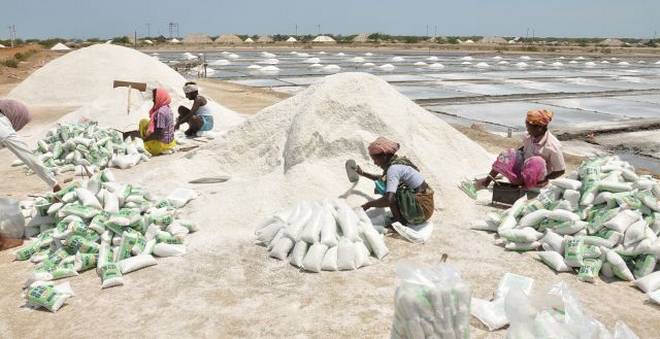Salt, table salt or common salt is a mineral composed primarily of sodium chloride (NaCl). Salt is one of the oldest and most ubiquitous food seasonings, and salting is an important method of food preservation. Salt is processed from salt mines, and by the evaporation of seawater (sea salt) and mineral-rich spring water in shallow pools. Salt is used in many industrial processes including the manufacture of polyvinyl chloride, plastics, paper pulp and many other products.
EBONYI WOMEN AND SALT PRODUCTION
Ebonyi State is referred to as The Salt of the Nation. The entire stretch of the state harbors a rich deposit of natural salt.
The story of Ebonyi women is that of ingenuity. It is the story of women, who, even in ancient times, created a technology with which from water, they produce and mould salt.
Uburu and Okposi Okwu in Ebonyi state are renowned for local salt processing and production.
Uburu
If you want to see pillars of salt, go to Uburu in Ebonyi. It’s not the story of the biblical Lot’s wife, who turned to pillar of salt, for looking back when Sodom & Gomorrah was being destroyed.
Indeed, they are women of uncommon strength, extraordinary initiative and drive; women whose efforts put to doubt the saying that women are weaker vessels, who depend on their husbands for survival. Through their effort, the community became known as o ji mmiri akpa aku (people who create wealth from water).
As people, in large numbers, from near and distant places, came to Uburu to buy salt, Uburu became a big centre of commerce. It was this large stream of people, who came into and left Uburu, on market days that attracted the interest of the Church of Scotland Missionaries to initially establish a church, a school and a hospital.
Uburu is blessed with four salt lakes and the saline water is called Mmahi. In every material particular, the lakes are beautiful and inviting. The scenery is enchanting, like a patch of Eden. The women go through rigorous labour, from one stage to another because the process of salt making has been manual. The salt producers put in many days’ labour to produce just a small cone of salt.
It was learnt that salt making is an all-comers affair in Uburu. Although all married Uburu women or women married to Uburu men are free to partake in the salt making process, there are requirements to be met.
Any woman interested in making salt would be initiated by way of “idu mmahi.” The initiation is done by Ogwu women.
Women menstruating are not permitted to step into the lakes. For a start, the woman secures a piece of land (salt plot). She prepares it by leveling, after which she provides big earthen pots, which may be five or more depending on her ability. The pots are arranged in a straight line. The pots are supported with big stones, which raise the pots completely from the ground. With wet clay soil, the stones are held together and in place. These large pots are Ofufu.
She will then be led by a group of young women and girls from Ogwu and other villages to the salt lake. They decorate their bodies, sing, dance and walk gracefully in a line. In that mood, they carry saline water from the lake to inundate every inch of the new comer’s salt plot in preparation for salt making.
Okposi Okwu
Traditional methods of salt production have continued in Okposi Okwu in Ebonyi state for about 400 years. The lake that supplies the brine was discovered almost immediately after the area now known as Okposi Okwu was inhabited. Two hunters (Ekwna Chita and Uta Anoo) discovered the lake and made their findings public when they discovered they could not quench their thirst with what they thought was ordinary water.
No matter how crude the method, salt preparation is not a craft but a scientific process. No wonder the ingenuity of the women who process the salt is attributed to the mythical instruction of a god “Mmahi.” The name equally refers to the lake itself. This belief is heightened by the fact that right from the inception of this local industry, the salt producers have been making use of solar energy in an intuitive manner.
The industrial hut is known as “Ewe” and is individually owned. Once a young woman has completed her honeymoon, she is initiated into salt making practices by her fellow women. Her more elderly friends and relations decide on a day to fetch as many pots of the brine as they consider necessary for her. On the appointed day, the brine would be used in making puddle with which the mud part of the “Ewe” would be built. Also executed on the same day is heaping of the same puddle to form a huge mound called “Okperede” at the front of the hut. This hillock, when dry, serves as a preservative bank for salt crystals.
On her first outing, the initiate is free to fetch brine directly from “Mmahi Ezi,” the main salt lake or from “Enyanwu,” the supporting pond. Her journey would, however, terminate at a point called Oninoubam (several metres from the lake) if her first outing coincides with her menstrual period. Here, she would stop and beckon to other women who willingly supply her with as many pots of the brine as she required. This is one of the many rules in and around the lake.
When she gets home, the young woman tills part of the mound that was built for her and pours more brine on it. The new puddle is allowed to dry under the sun for several hours so that evaporation of water content takes place. The hardened puddle, now rich in salt crystals, is further broken into smaller pieces and poured into “Ofufu” (a pot perforated at the base). This pot is built into the side of the Ewe and has a fiber plug for the hole at the base. Above this hole is placed a circular piece of shard. When filled with the salty earth, the setup stimulates a simple sand filter.
At this stage, fresh brine is poured into the pot and a number of hours is allowed for the salt crystals in the earth to dissolve. Usually in the evenings, the fiber plug is removed externally. Immediately after removal, a smaller pot (ite eja) is put under the fixed pot for the purpose of overturning the shard at the base of the bigger pot so as to prevent sand from entering the filtrate. Further precaution is taken by pouring back into the filtering pot the initial drops of the percolation. The result is that the saturated filtrate “Ochichi” is not only sparkling, but yields enough pure salt crystals.
Boiling of brine to extract salt poses a big problem because of the unavailability of woods. Grass served as fuel in the past. Other combustible materials were sourced from surrounding villages and beyond. Many years ago, a particular type of pot “Oreohu” was used as an evaporation crucible. Later, this gave way to kerosene tins; but now, it is enamel basin that is in vogue.
Before the advent of packaging, baking of salt was the only option for marketing the product. As in the case of boiling, earthen wares were used for this purpose, but now metal bowls dominate because they are more durable and more convenient. The baked cones enable salt traders the opportunity of travelling far and wide to places where the commodity is in great demand.
The economic importance of the Okposi salt industry might be underestimated by outsiders, but the indigenes know that it ranks first among what made Okposi famous in the pre-colonial era. Once a highly valued merchandise, the salt attracted dealers from all parts of former Eastern and some parts of Northern Nigeria to one of the most famous markets at the time, Odenigbo Okposi. When the market lost its pride of place to the Uburu Slave Market, Okposi salt still formed the bulk of the supply in that market since Uburu salt production is seasonal owing to floods.
It would be recalled that Okposi supplied the entire Eastern Nigeria with salt during the Biafran/Nigerian Civil War. Biafran scientists, after a series of tests, declared the brine from Okposi Salt Lakes as having the highest salinity among all lakes in Eastern Nigeria. They built an industry close to the lake and taught the local women new production techniques, including the use of “alom” to effect sedimentation of dirt before decantation and ultimate filtration. The now dilapidated industry still stands as a monument of the glory that was Biafra.
One wonders why, nearly 40 years after the civil war, the rehabilitation of Okposi salt industry has not been undertaken by the state or federal governments. The fact that Okposi is strategically located and the salt lake is only ten metres from Federal Government College, Okposi presents, in my opinion, a compelling investment opportunity for entrepreneurs.
Regrettably, the salt trade is declining. This is attributable to the saturation of the country with cheap imported salt from all manner of places. Many young women are no longer stepping into the shoes of their mothers, who created wealth from water because of Western education and migration to other places in search of greener pastures.
Industrial Salt Production and Processing
Solar Evaporation Method
This is the oldest method of salt production. It has been used since salt crystals were first noticed in trapped pools of sea water. Its use is practical only in warm climates where the evaporation rate exceeds the precipitation rate, either annually or for extended periods, and ideally, where there are steady prevailing winds. Solar salt production is, typically, the capturing of salt water in shallow ponds where the sun evaporates most of the water. The concentrated brine precipitates the salt which is then gathered by mechanical harvesting machines. Any impurities that may be present in the brine are drained off and discarded prior to harvesting.
Usually two types of ponds are used. First is the concentrating pond, where the salty water from the ocean or salt lake is concentrated. The second is called the crystallizing pond, where the salt is actually produced.

Crystallizing ponds range from to 40 to 200 acres with a foot-thick floor of salt resulting from years of depositions. During the salt-making season of four to five months, brine flows continuously through these ponds. This is a saturated brine solution, containing as much salt as it can hold, so pure salt crystallizes out of the solution as the water evaporates. Natural chemical impurities are returned to the salt water source.
Rock Salt Mining Method
This is the second oldest method of producing salt – underground mining. This is probably the most dramatic method of gathering salt. Large machines travel through vast cave-like passageways performing various operations.
Salt mines are among the safest of mines. They are also the most comfortable to work in. While mine temperature varies with depth, the average temperature remains about 70° F year round.
Salt may appear in veins, as does coal. Veins are the original bedded salt deposits. Salt also may be found in domes, which were formed when Earth pressures forced salt up through cracks in the bedrock from depths as great as 30,000 or 40,000 feet; they resemble plugs of almost-circular shape a few hundred yards to a mile across. Some domes occur close to the surface. Both domes and veins are mined in a similar way.
To enter a salt mine, miners go down a shaft from the Earth’s surface to the salt bed. The shafts also are used to deliver a constant supply of fresh air to the miners while they work hundreds to thousands of feet below the surface. Most mine shafts are lined with a concrete wall called a shaft liner.
The first operation is undercutting. Large machines cut a slot 10 or more feet in depth across the bottom of a solid salt wall. This leaves a smooth floor for picking up the salt after blasting.
Next, small holes are drilled into the salt wall to a depth of 10 or more feet and explosives are loaded into the drilled holes. After the work shift, the explosives are set off electrically. Several hundred to several thousand tons of rock salt are blasted and fall onto the mine floor.
There are special equipments used to load and haul the salt to machines that crush and feed the salt onto a conveyor belt. The lumps are conveyed to a series of stations for crushing and additional sizing of the lumps. The salt is then placed in a storage bin to await hoisting to the surface.
Vacuum Evaporation Method
Another method of salt production used is the evaporation of salt brine by steam heat in large commercial evaporators, called vacuum pans. This method yields a very high purity salt, fine in texture, and principally used in those applications requiring the highest quality salt.
The first part of the operation is known as solution mining. Wells are drilled from several hundred to 1,000 feet apart into the salt deposit. These wells are connected via lateral drilling, a recently developed technology. Once the wells are connected, the solution mining operation begins: water is pumped down one well, the salt below is dissolved, and the resulting brine is forced to the surface through the other well. It is then piped into large tanks for storage.
Next, the brine is pumped into vacuum pans. These are huge closed vessels under vacuum about three stories high. They are normally arranged in a series of three, four or five, with each one in the line under greater vacuum than the preceding one. This series of vacuum pans operates on a very simple principle: Whenever pressure is lowered, the temperature at which water will boil is also lowered. For instance, under normal air pressure at sea level, water boils at 212°F. But at ten thousand feet above sea level, where air pressure is much less, water boils at 194°F. Vacuum pans may operate at as low as 100°F.

In the vacuum pan process, steam is fed to the first pan. This causes the brine in the pan to boil. The steam from the boiling brine is then used to heat the brine in the second pan. The pressure in the second pan is lower, allowing the steam made by the boiling in the first pan to boil the brine in the second pan. The pressure is reduced still further in each succeeding pan. This allows the steam made by the boiling brine in the previous pan to boil the brine in the next pan. While the boiling operation could be done with just one pan, several pans in a row produce more salt per pound of steam, thus allowing greater energy efficiency.





Leave A Comment